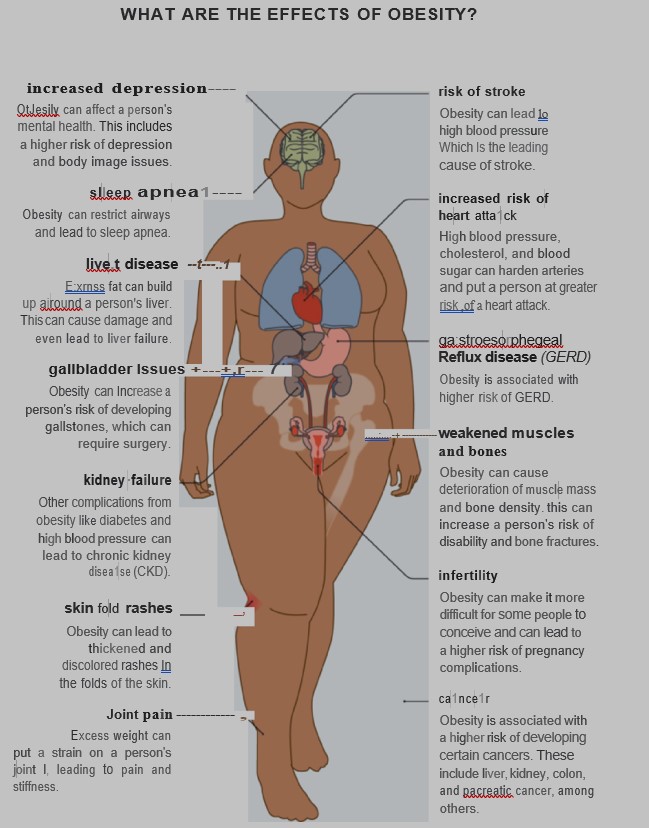A nurse is providing nutritional education to a client who is obese. The nurse should include in the information that which of the following gastrointestinal disorders is commonly associated with obesity?
Gastroesophageal reflux disease
Crohn's disease
Peptic ulcer disease
Celiac disease
The Correct Answer is A
GERD is a chronic condition in which stomach acid and contents flow back into the esophagus, leading to symptoms such as heartburn, regurgitation, and chest pain. Obesity is a significant risk factor for developing GERD. The excess weight can put pressure on the stomach, causing the contents to reflux into the esophagus more easily. Additionally, obesity is associated with a higher prevalence of hiatal hernia, which can further contribute to the development of GERD

Crohn's disease, Peptic ulcer disease, and Celiac disease are not commonly associated with obesity:
Crohn's disease is a type of inflammatory bowel disease that can affect any part of the gastrointestinal tract. It is not specifically associated with obesity but rather has complex genetic and environmental factors as its causes.
Peptic ulcer disease refers to the presence of open sores in the lining of the stomach or small intestine. While obesity may be a risk factor for gastric ulcers, the association is not as strong as with GERD.
Celiac disease is an autoimmune disorder triggered by the ingestion of gluten, a protein found in wheat, barley, and rye. It is not directly related to obesity but is associated with a specific immune response to gluten in genetically susceptible individuals.
Nursing Test Bank
Naxlex Comprehensive Predictor Exams
Related Questions
Correct Answer is A
Explanation
Bananas: Bananas are a suitable choice for a client taking digoxin and furosemide. Digoxin is a medication commonly prescribed for heart failure and certain heart rhythm disorders, and maintaining adequate potassium levels is important while taking this medication. Bananas are a good source of potassium and can help prevent or correct low potassium levels (hypokalemia), which can be a potential side effect of both digoxin and furosemide.
Green beans: Green beans can be included in the client's diet when taking digoxin and furosemide. While they are a healthy vegetable choice, they do not have a direct impact on the potassium levels affected by these medications.
Blueberries: Blueberries are a nutritious fruit choice, but they do not have a specific relevance to the client's medication regimen of digoxin and furosemide. They can be part of a balanced diet but are not specifically recommended or contraindicated in this context.
Cucumbers: Cucumbers are a refreshing vegetable choice, but they do not have a direct impact on the potassium levels affected by digoxin and furosemide. While maintaining hydration is important, other foods would be more relevant for addressing potassium needs.

Correct Answer is B
Explanation
2-hour glucose tolerance test level 150 mg/dL: The 2-hour glucose tolerance test level of 150 mg/dL indicates elevated blood glucose levels after a glucose challenge. This finding suggests impaired glucose tolerance or impaired fasting glucose, which are considered pre-diabetic states. It is important to report this finding to the provider for further evaluation and consideration of interventions to prevent or delay the development of diabetes mellitus.
Fasting blood glucose 70 mg/dL: A fasting blood glucose level of 70 mg/dL is within the normal range. Typically, fasting blood glucose levels below 100 mg/dL are considered normal.
Therefore, this finding does not indicate a concern for diabetes.
Glycosylated hemoglobin 5%: A glycosylated hemoglobin (HbA1c) level of 5% is within the normal range. HbA1c is a measure of average blood glucose levels over the past two to three months, and a level below 5.7% is typically considered normal. Therefore, this finding does not indicate a concern for diabetes.
Casual blood glucose 90 mg/dL: A casual blood glucose level of 90 mg/dL is within the normal range. Casual blood glucose levels below 140 mg/dL are generally considered normal.
Therefore, this finding does not indicate a concern for diabetes.
Whether you are a student looking to ace your exams or a practicing nurse seeking to enhance your expertise , our nursing education contents will empower you with the confidence and competence to make a difference in the lives of patients and become a respected leader in the healthcare field.
Visit Naxlex, invest in your future and unlock endless possibilities with our unparalleled nursing education contents today
Report Wrong Answer on the Current Question
Do you disagree with the answer? If yes, what is your expected answer? Explain.
Kindly be descriptive with the issue you are facing.
